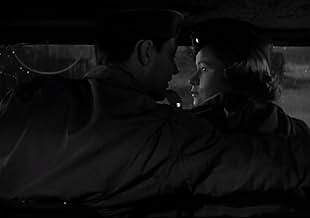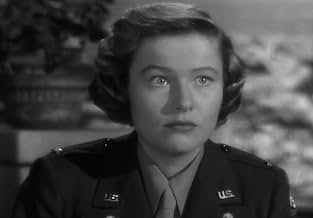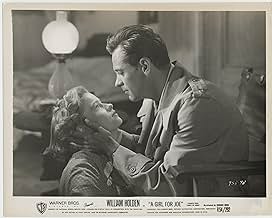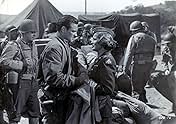CALIFICACIÓN DE IMDb
6.5/10
743
TU CALIFICACIÓN
Agrega una trama en tu idiomaDuring World War II in Italy, an American sergeant and WAC lieutenant take time out for romance.During World War II in Italy, an American sergeant and WAC lieutenant take time out for romance.During World War II in Italy, an American sergeant and WAC lieutenant take time out for romance.
- Dirección
- Guionistas
- Elenco
- Premios
- 1 premio ganado en total
Argentina Brunetti
- Signora Maduvalli
- (sin créditos)
Francesco Cantania
- Barber
- (sin créditos)
Frances Canto
- WAC
- (sin créditos)
Philip Carey
- Military Police Sgt. Fred Miller
- (sin créditos)
Amelia Cova
- Lea Maduvalli
- (sin créditos)
Ashley Cowan
- Patient
- (sin créditos)
Danny Davenport
- Driver
- (sin créditos)
Anna Demetrio
- Mamma Mia
- (sin créditos)
- Dirección
- Guionistas
- Todo el elenco y el equipo
- Producción, taquilla y más en IMDbPro
Opiniones destacadas
It would be easy to pass off Force of Arms as just another post-WWII action/romance movie until you're a few frames into viewing it. Surprisingly realistic with actual combat footage interspersed with filming. Strong yet sensitively-understated performances by Holden, Olson, and, in a supporting role, Frank Lovejoy. An inspired and superior script helps convey the chaos of combat, its effects on those who are scarred by it, and the powerful force of love that can somehow emerge in the midst of the sheer will to survive. A classic that feels as real in 2017 as when it was filmed.
People keep comparing this film with "A Fairwell To Arms" (1932). If that is true, then it can also be seen as a stepping stone to "The Americanization of Emily" (1964) — highlighting how changing American attitudes toward war have become gradually more cynical.
Seems like the "Emily" team — writers and director — might have been influenced by Sgt. Joe 'Pete' Peterson (Holden character), transposing Garner's Charlie Madison to be an updated version of same. 1932 > 1951 > 1964.
All three successfully integrate Romance and War, ably supporting the theme that Love is the stronger force. So why do we keep on making war?
Seems like the "Emily" team — writers and director — might have been influenced by Sgt. Joe 'Pete' Peterson (Holden character), transposing Garner's Charlie Madison to be an updated version of same. 1932 > 1951 > 1964.
All three successfully integrate Romance and War, ably supporting the theme that Love is the stronger force. So why do we keep on making war?
I really liked this movie. I fast forwarded through the love scenes though. I am a Holden fan and I seem to like his snide comments he always seems to make. His comments are usually like "gallows humor". In times of stress everything seems to take on a different view or meaning. I also liked where Holden seems to exhibit PTSD. He talks about the horror of the battlefield and his men dying for no reason. I liked this because I thought the US Government did not want anything but us the good guys and the enemy the bad. Most war movies show us never getting hurt and the enemy all dying, What tipped me off was the word "San Pietro". John Huston made a movie called that and it was banned by the Government and not shown because it showed people actually getting killed. Lastly, all the equipment looked real and used in the real manner even down to the mail room! Usually I can find many errors in guns and ammo. Another good movie to watch is, "Pork Chop Hill" with Gregory Peck. You actually see men using body armor and guns and ammo used in the proper manner.
It's been tough fighting in Italy. Sgt. John 'Pete' Peterson (William Holden) and his men are getting pulled out for five days after a terrible battle. He meets WAC Lt. Eleanor MacKay (Nancy Olson). Maj. Blackford (Frank Lovejoy) has a battlefield commission for him. He gets closer to Lt. MacKay and soon has to go back to the front.
This movie is divided between love and war. The love part has a melodramatic romance with some limited heat. She's a good girl on the rebound from a trauma. He's been in the thick of it. The romance is rather old fashion. The war part has some functional battles with a mix of real and staged footage. The fighting is somewhat realistic with many friendlies killed.
This movie is divided between love and war. The love part has a melodramatic romance with some limited heat. She's a good girl on the rebound from a trauma. He's been in the thick of it. The romance is rather old fashion. The war part has some functional battles with a mix of real and staged footage. The fighting is somewhat realistic with many friendlies killed.
Just caught it on Turner. The reviews calling it "routine" show how dull-normal some people are. In fact, the old pro Michael Curtiz (look him up) brings an extraordinary sensibility to the film. Gone are his romantic stylings of Casablanca and Robin Hood, his lush, overdone Warner's agreeable foolishness. Instead, he portrays war as bitter and without glory, full of random death and meaningless violence. The three combat sequences are superb, and Holden, as he would later demonstrate in "Bridge on the River K" is brilliant as a reluctant soldier who has no sense of glory and no wish to be a hero, but is nevertheless the everyman Infantryman, who knows he must do his duty. Curtiz doesn't turn this evocation of battle into boy's fantasy; it's hard, bitter, terrifying and brutally unfair to children and especially young American men who never thought they'd be dying in the slopes of Mt. Casino. The romance is nicely done, even if the ending is trite (but, in the way that cheap melody can be, amazingly satisfying). Olsen and Holden have great chem (as they proved in three other films as well) and all in all, the whole piece is kept in a register of near-realism that's very affecting. A neglected minor gem from the great Curtiz.
¿Sabías que…?
- TriviaOne of 4 films that William Holden and Nancy Olson appeared in together, the others being El ocaso de una vida (1950), De mala entraña (1950), and La amarga obsesion (1951).
- ErroresIn this story set in the 1943 WWII Italian Campaign, Lieutenant MacKay and the other female characters all wear their hair shorter and their skirts longer, in the trending fashions of the early 1950s.
- Citas
Sgt. Joe Peterson: You mean you were a civilian once?
Lt. Eleanor MacKay: Oh, if you consider schoolteachers civilians.
Sgt. Joe Peterson: You, honest?
Lt. Eleanor MacKay: Mm-hmm.
Sgt. Joe Peterson: Well, and me without an apple!
- ConexionesFeatures San Pietro (1945)
Selecciones populares
Inicia sesión para calificar y agrega a la lista de videos para obtener recomendaciones personalizadas
Detalles
- Tiempo de ejecución1 hora 39 minutos
- Color
- Relación de aspecto
- 1.37 : 1
Contribuir a esta página
Sugiere una edición o agrega el contenido que falta

Principales brechas de datos
By what name was La fuerza de las armas (1951) officially released in India in English?
Responda






























